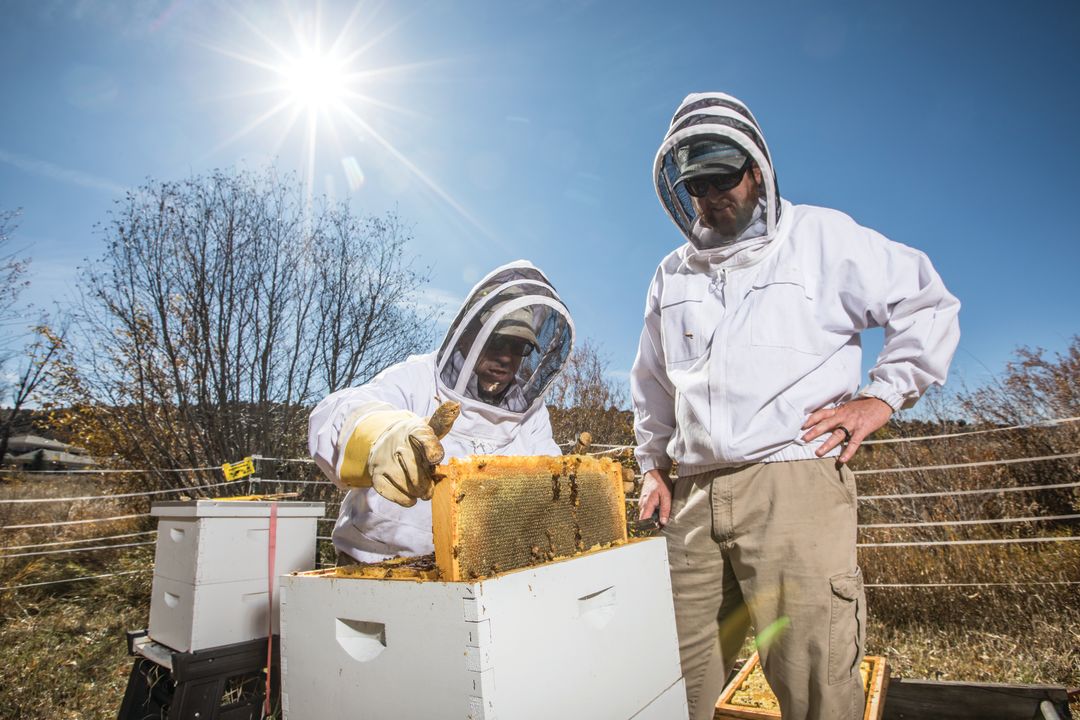A Groundskeeper's Bee Game

Eagle Ranch Golf Club beekeepers Doug Seurer and Derek Rose harvest honey that’s a best seller at the pro shop.
Image: Zach Mahone
On any given summer day at the Eagle Ranch Golf Club, visitors might notice a swarming population of honey bees—120,000 strong—buzzing from green to green. At least that’s what Eagle Ranch Golf Club course superintendent and head beekeeper Derek Rose estimates the club’s two hives swell to each summer when the wildflowers (akin to honey bee fuel) are in full bloom. About five years ago, Rose thought adding hives would be a good way to further the club’s environmental mission and support the struggling honey bee population in North America, where a quarter of all bee species are at risk of extinction. The club had already installed birdhouses on-site in a collaborative project with the Audubon Cooperative Sanctuary Program, and Rose was ready for a new challenge. The only problem? “I had zero beekeeping experience whatsoever,” he laughs.
Lucky for Rose, after five years of tending hives—two wooden bee boxes stationed several hundred yards from the green near the course’s headgate that siphons irrigation water from Brush Creek—he’s come to realize that the worker bee analogy wasn’t coined by chance. Over our long winters, the hives are pretty low maintenance—in the fall, golf club employees provision the queen and her brood with enough honey (their sole food source) to sustain the colony until spring, checking in once in a while to ensure that the bees have enough to eat. In the summer, the population swells with the hives’ honey production, which hums with activity as a single bee typically flies up to five miles each trip looking for nectar and pollen before bringing it back to the hive. Rose monitors the hives throughout the year, visiting each one every other week during the summer. His role as human worker bee commences, however, in mid-summer, when it’s time to harvest the honey. “The tough part is that, in the middle of the summer, we need to move the hive to harvest honey, and each hive can weigh upwards of 80 pounds—a really awkward 80 pounds,” he explains. Frames from the hive are pulled out, and wax the bees use to cap each comb is cut before the frames are placed in a centrifuge and the honey is spun out into barrels—as much as 250 pounds of gooey, golden nectar in a good year.
Rose didn’t take any of the hives’ honey the first year so the colony could make it through the winter, but as the hives have become more established, honey production has blossomed. A few summers ago, when the Eagle Ranch Golf Club started offering its honey for sale at the pro shop, members and locals gobbled up the entire harvest within days; since then, they’ve had to enforce a two-jar maximum per person. “People love it—now we put an announcement on our Facebook page and send out an email telling people when we’ll start selling the honey,” says Rose. “It’s been really rewarding, the golfers love it, we love taking care of the bees and watching the hives grow year after year.” And all the buzz that’s come along with it.






































